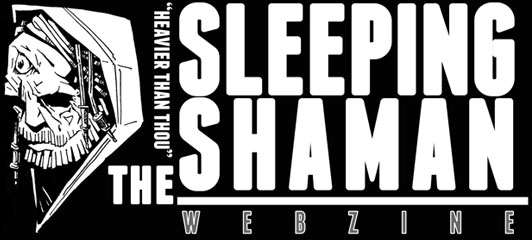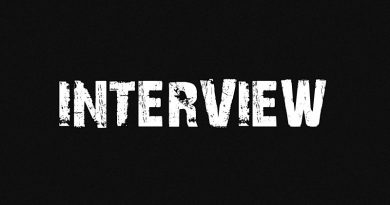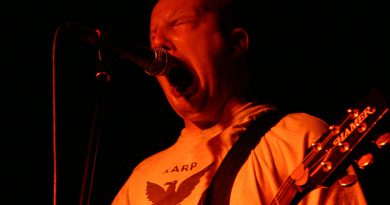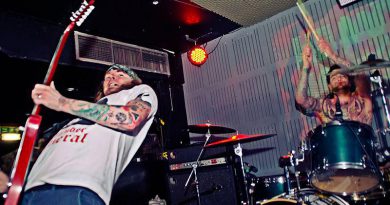In Search Of Tone: Ryan, Kevin & Bryan Of Doomsday Profit
I always thought it would be cool to learn of a band at the early stages of its life. See them perform in the smallest of venues and when they hit the big stages I can reminisce of when I saw them back at a record store like Static Age. I think I may have that opportunity with Doomsday Profit. These four guys are some of the nicest I’ve come across, create some epic heavy music and have the drive for success.
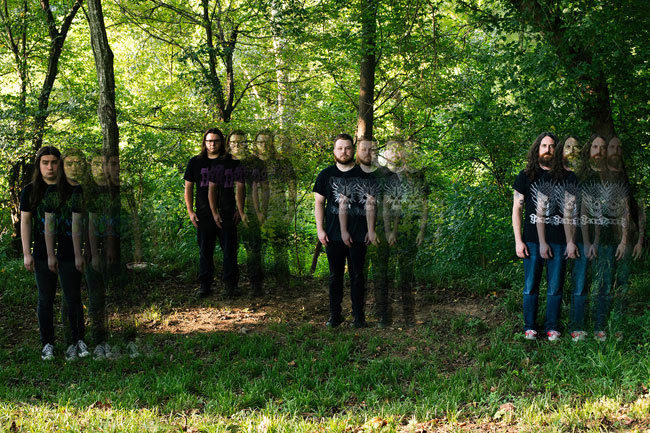
One day twenty years from now when they are playing In Idle Orbit front to back at their anniversary show at PNC Arena in Raleigh, I can say I heard those songs live when they first came out! On top of that, I got to interview 3/4 of the band, Ryan Sweeney (bass), Kevin See (guitar), and Bryan Reed (vocals and guitar) to learn about the gear they used in these early stages.
Thank you guys for meeting with me to discuss all things music. I typically start with gear in these interviews, and I should already know these answers after seeing you guys live twice recently, but can you tell me a little about the amps you’re currently using?
Bryan: We are a moving target and full of surprises, you don’t know anything [laughs]. Who wants to start?
Ryan: I guess I’ll go first because mine will be the quickest and easiest. I’m running a Sunn Concert Bass Head that goes into a Custom Schroeder. I found it, well I didn’t find it, Kevin was stalking Music Go Round after I blew up my other cab [laughs]. It was a crappy 4×10 I got off Craigslist. I tried to fix it but ended up breaking it for good with a Quilter head. So Kevin found the Schroeder for me and it’s a 2×10 and 2×12, it really covers everything.
Kevin: [Laughs] Yeah, it’s a 2×10 and 2×12 with a tweeter.
Ryan: Yes, he knows more about my gear than I do [laughs].
Bryan: Ryan is our gear minimalist, so if Kevin and I jump in about his gear it’s because we nudged him rather forcefully [laughs].
Ryan: I didn’t have pedals before this band. I had a combo amp. I’m learning the ways, but I do like keeping it paired down and I like the sound of the Sunn. I’ve played around with some distortion pedals, but they really don’t sound quite right. I’m really pleased with how the Sunn sounds on its own.
I got one of the new Electro Harmonix Mig 50 reissues, it’s much more of a clean pedal platform but it’s super loud…
Bryan: You’re also not using a power amp or a slave unit or anything to push the wattage.
Kevin: Yeah, and each speaker on the Schroeder handles 500 watts.
Ryan: In total the cab handles 2000 Watts on its own. I wanted something that could handle all 800 watts of the Quilter, just in case and I ended up using a head that’s far less than that [laughs]. The cab is super light too. It’s 87 pounds which, I feel like it’s a unicorn. I don’t know how we stumbled upon this cab but it’s fantastic.
Bryan: It makes every other bassist jealous when they’re walking around with their refrigerators. Ryan is bicep curling his [laughs].
Amp wise for me, that has changed. Ryan alluded to the fact that before this band we didn’t really have doom gear. We weren’t sitting in our bedrooms playing 100 watt amps [laughs]. The first head and cab combo I got was one of the cheap Acoustic 4×12 used for 100 bucks and a Bugera T50 head. It has more of a modern metal sound that I never liked, and it had some minor issues. I got an Orange Micro Dark pretty early on that I can play at home, and it was loud enough to get started, but the first high powered amps that I got, I still have.
I have a Traynor TS-50 B which is a 50 watt solid-state from the 80s or 90s that was used a lot with Shellac or The Jesus Lizard and I have a Laney AOR 100 watt amp. That was my go to for a while, but it’s so heavy and frankly it’s overkill to have 100 watts. I got one of the new Electro Harmonix Mig 50 reissues, it’s much more of a clean pedal platform but it’s super loud and it’s easier to move around because it’s a smaller footprint. That’s been my primary amp for almost a year.
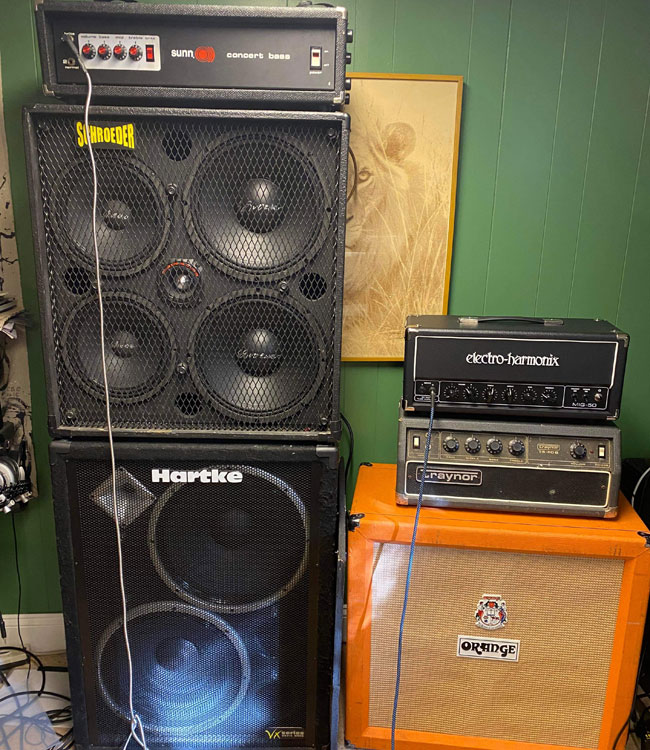
I keep a Quilter Overdrive 202 in the bag as a backup and use it in practice sometimes. My cabinet is an Orange PPC 4×12 standard. I also have an Ampeg V4 cab with whatever stock speakers are in that. I don’t bring it on the road because it’s bulky and the Orange 4×12 has been doing me a lot of good. One thing I will change is adding wheels [laughs].
Kevin: My amp is the EVH 5150 head with EL 34‘s, I don’t run any drive pedals with that at all, I just run the blue channel the whole time turned way up. It already has the tube screamer going into the JCM vibe by itself, so I turn it up. There’s nothing else to do.
Bryan: It has a more of a classic metal tone than a lot of doom bands would at least admit to [laughs]. I think it sounds great and I tend to be more on the saggy saturated fuzzy side of the spectrum. I think it has a nice balance and as you have heard, Kevin never has an issue punching through the mix.
Kevin: For cabinets, I just use a Marshall 1960A with stock Celestion G12T-75’s live and on the album we used our producer Scotty’s cab.
Bryan: Interestingly, his cabinet has two G12T-75’s and two V30’s so is basically a hybrid of our cabinets.
My amp is the EVH 5150 head with EL 34’s, I don’t run any drive pedals with that at all, I just run the blue channel the whole time turned way up…
Very cool, and I feel I understand more of what you’re talking about. When I first started all that would have gone over my head. What about guitars?
Kevin: For guitars, on the album I didn’t have the Gibson Flying V that I was playing live. I played a 1994 Gibson Les Paul Classic on the recordings. I bought the Flying V because it sounds just like the Les Paul, they both have the 496R and 500T pickups and I like how they sound. They are both ‘94s, the same age as me.
Bryan: Kevin likes guitars born in the same year he was [laughs].
Kevin: Yes [laughs]. The Flying V is fine by the way. It has a nice red ding on the back of it though.
Good I’m glad it’s OK. You said before the show you wanted it to be road worn though. I didn’t know you would actually throw the guitar off the stage mid song [laughs].
Kevin: I’ve had strap buttons strip out of the hole before, but this is the first time a cloth strap broke.
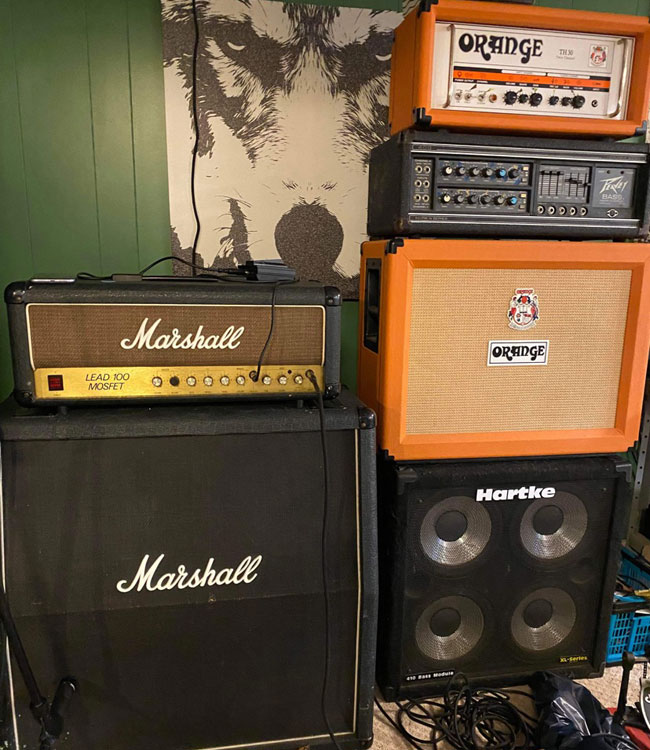
That’s crazy, I’m glad it’s not damaged though. It made for an epic moment in the show. I thought you were going for Tradd’s drums next. What about you Ryan, what are you using for bass?
Ryan: I play the good ol’ Precision bass, not even a Fender but a Squier, inspired a bit by Dixie Dave of Weedeater. I saw that’s what he played and if it’s good enough for Dixie Dave it’s good enough for me. I think he also plays out of Sunn or at least used to.
Bryan: You’re pretty close to his rig. He has a weird pre-amp pedal from Dunlop I believe, but other than that you pretty much have it.
Ryan: Yeah [laughs]. Between us Bryan, I basically have Dixie Dave’s set-up and you have Wata from Boris.
Bryan: Oh no. I don’t have nearly enough amps for that. That is an area of inspiration for sure. I do not play a 1986 Les Paul Custom however. For shows, I’ve been playing one of two guitars and both LTD EC 1000’s. One is the EC 1000 with a Seymour Duncan JB 59 and the other is the EC Black Metal which has a Seymour Duncan Black Winter bridge pick up. I think you may have seen me play both of those at this point.
Josh: Yes, I believe you are correct because you played different guitars at each show.
Bryan: I have a few others at home that I use. I have an EC-256 that was the first guitar I used for this band. I used Matt Pike Dragonaut Signature pickups in it, but I need to get some work done on that. The other two have been treating me quite well.
I play the good ol’ Precision bass, not even a Fender but a Squier, inspired a bit by Dixie Dave of Weedeater…
What about pedals?
Bryan: One thing I should give a plug for is our buddy Mike DeLoatch. He is the original Crystal Spiders guitarist and is currently singing in a band called Hot Rats. He’s a pedal builder for Alexander Pedals during the day and then builds his own stuff. I think it was 2020 he built a batch of Boost Pedals that he called BLM and basically gave them out to any of his friends if they gave a donation to a bail bond or social justice organization. It is a gnarly little boost pedal. I’ve used it as the foundation of my tone or as a lead boost. The gain sweep on it is incredible and I believe he will still do a custom one off if he’s asked nicely. So good cause, good pedal.
I have been in the market for a boost pedal! Thanks for sharing this info I appreciate it and donating to a good cause and getting a pedal is a definite win/win. What else is on your pedalboard?
Bryan: I’m not that big on subtle effects so I have quite a bit [laughs]. I have a floor full of pedals around me right now. On the record I used the AOR and a Quantum Mystic overdrive though.
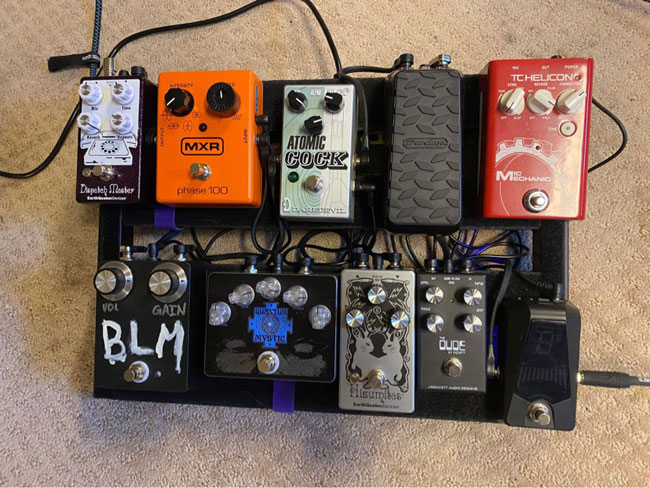
Ohh, how is that! I’ve been wanting one. I guess I want everything! After every interview there is always something new I want [laughs].
Bryan: [Laughs] G.A.S. is a real thing. The Quantum Mystic is awesome. I have the Quantum Mystic and the Raw Heart, which is both the Quantum Mystic and the Witchburner, I never ended up using the Witchburner side so I got the smaller version to save space. It covers such a wide range but doesn’t really do low gain. It does have an active EQ which is nice. In my case, I can bring out the bass and the mids. That’s really the base sound. I do use a phaser on the back half of Cestoda. We are in writing mode right now and I’ve been experimenting with more psychedelic sounds. When we practice, I end up pairing everything down to a distortion, phaser and echo. I also have a volume pedal, but I use it as a mute rather than a noise gate. I put the volume pedal after the dirt and before the modulation which right now is a Phase 100 and a Dispatch Master. This way it will cut the sound but leave trails of modulation ringing out.
Ryan: I was pretty minimal for pedals as well. I used a Wah on Scryers but recently I have scraped the wah and have been using a phaser. I’m in the market for a phaser, I’m borrowing one from Kevin and Bryan and trying each out but I definitely like it better than the Wah on Scryers. Other than that I only used a tuner. Scotty used a dark glass overdrive on the recording.
Bryan: Scotty used mics for each of our amps but also recoded us with a direct line. So he may have blended some effects after the fact. Like Ryan said, I know he blended a Darkglass Overdrive for Ryan’s bass tone to give it a scuzzy undertone, but it was basically like having it bi-amped where he was running the Concert Bass pretty clean and then had the dirt layered underneath it.
That goes into an Electro Harmonix POG2, which I only use for the solo on Consume The Remains, it’s a big ol’ pedal and I use it for only one song [laughs]…
Kevin: My setup stays pretty consistent. I do a four cable method. Before I go into the amp, I start with a Korg Pitchblack Custom Tuner to a Morley Bad Horsie VAI-1, it’s a little more subtle of a wah than a Cry Baby. I also like how you don’t have to step down on it to turn it on, instead, it has a switch at the tail end you step on and it starts at the bottom of the sweep. When you take your foot off, it turns off. That goes into an Electro Harmonix POG2, which I only use for the solo on Consume The Remains, it’s a big ol’ pedal and I use it for only one song [laughs].
All that goes into the amp, then I have a separate chain that runs through the effects loop. I have a Boss Noise Suppressor that runs into a Source Audio EQ2 that I use as my boost. Then I have an Ibanez Chorus Mini which runs into a Strymon Volante. That pedal was all over the album, it’s definitely the MVP for the album. Bring Out Your Dead, the closing song, my track on that is all the Volante. That’s me just switching loops on the pedal. The last two mintues of the track I had my hands off the guitar and I was just tweaking the pedal live. After that I have an MXR Reverb which I have set with a Dunlop Mini Volume plugged in as an expression pedal.
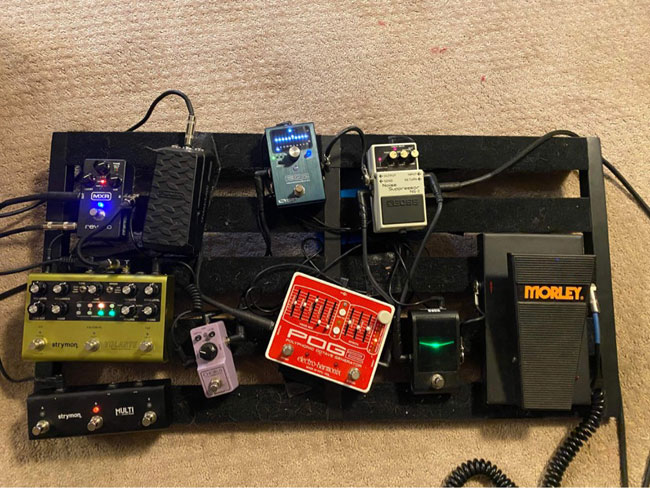
That’s really cool. One of my questions was how you created the sounds on Bring Out The Dead so thank you for sharing that.
Bryan: That song came about unexpectedly. We had extra time in the studio, but Tradd had to leave early so the three of us had an extra day. I had a drone riff I’d been working on, so I went in first and played that until I got tired of playing it, which as it turns out was about twelve minutes [laughs]. Then Kevin went in and played over the top of it and then Ryan went in a did a couple of takes on bass.
Ryan: I did ONE take on bass! I did try the Wurlitzer he had in the studio to try an add some keys but anything I played didn’t work in the song so maybe that was my other takes.
Bryan: We debated whether to include it. Without it In Idle Orbit is an EP because that track takes up twelves minutes it pushes it into LP territory. I still think of it as an EP, but we like that song as a dust settling moment after the record proper.
I’m glad you added it because it’s fantastic. You mentioned earlier you guys are in writing mode. What is your songwriting process like and has it changed with writing the new stuff?
Bryan: It may be too early to tell but, one change is Kevin is doing a lot more riff writing. It’s also different because the songs Crown Of Flies and Consume The Remains were quarantine creations. I created the riffs but the bridges and solo sections everyone writes their own parts, everything on In Idle Orbit started with a riff that I initially created and brought to the group, and we pasted them together with other riffs that were matched to lyrics I had written separately. It was very collaborative, and I wasn’t telling anyone how the songs should go, but I was the origin of the early riffs and lyrical ideas. This time it’s opening up more with Kevin writing some really strong riffs. Nothing is really fleshed out yet, other than No Salvation which we played last time you saw us. We do have another song called Doomsday Profit that we took out of the set because we want to rework it a little.
Ryan: I wrote that main riff and it’s not as good as what Bryan and Kevin are spitting out [laughs].
Bryan: We have different inspirations that we pull each other in and it’s an integral part of how the songs are arranged and finalized. I can write a mean sludgy riff, but it will come out with more groove, space and melody because the guys I’m playing it with. I say we’re going in a more psychedelic path but then we write some of the heaviest shit we have written [laughs] so these songs take on many changes and there is no telling where this next record will end up. We’re playing with more psych rock bands and recently opening up for REZN, was very inspiring to see the huge dynamic shifts they were bringing to the table. Those dynamics are something I strive to emulate.
Kevin: The songs that got the best reaction were ones that we felt maybe a little too off the map. I was going into it thinking people would be drawn more to Crown Of Flies or Scryers Of The Smoke. It surprised me, but I like that people enjoyed the weird stuff so let’s go with it.
We have different inspirations that we pull each other in and it’s an integral part of how the songs are arranged and finalized…
My wife has a bass guitar and when we try to write riffs, all I do is double the bass or sit on the E. How to do create unique riffs that mesh well within the band?
Bryan: First of all, there is nothing wrong with sitting on that open E.
Ryan: They keep telling me that, but I try and do more than that [laughs]. I like to walk however. For me, it’s just experimenting with those walks. The guys will stay on the riff as I write the bass part. I’ll stick to the root notes and walk around the scale while trying to fit in rhythmically and see how it sounds. When we started the band, I was playing pretty much exactly what Bryan was playing in the main riff. So that’s really where I start. I’ll play the main riff and then I get curious. On Cestoda for instance, in the beginning I play the same riff but towards the end I came up with a walk that we put in giving it more movement. Bryan and Kevin have you noticed anything different?
Bryan: I think a lot of it is that you stay in the pentatonic shape, which is essentially what I’m doing as well. Kevin does more because he’s better at his instrument [laughs]. When I pick up the bass, I usually sit on the root note or chord. A lot can be done rhythmically with just the root notes and the dynamics come in when the guitar and bass lock together and then drift apart from each other. Black Sabbath is just about everyone’s favorite band [laughs] and I think Geezer’s riffs are just as vital as Iommi’s and they are a perfect example of locking in riffs and then drifting apart playing different riffs to move the song along.
Kevin: The process of writing bass riffs, or songs in general, record what you do and listen back. Let your ears be the judge and repeat, repeat, repeat.
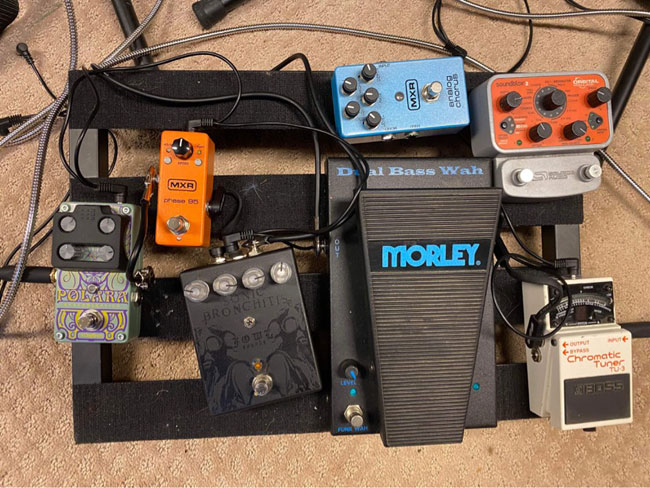
When I have an off day I get easily discouraged. What do you guys do when you’re having an off day?
Ryan: You’re always going to have an off day and it can be disheartening. Playing with other musicians helps. You can bring a riff to them that you like and hear them get excited. They add more to bring it to life in a way that you didn’t even imagine, I think that’s the juice that keeps it going.
Bryan: I agree and definitely think that’s an advantage to playing in a band vs a solo artist. I may have an idea that I may not think is great, but I’ll play it for my bandmates, and they will either confirm that’s awful please don’t play that again or they will like it and we’ll make it into something. I’m only adding maybe 25% of the picture also. It’s never going to be complete with just me. It’s going to go in a different direction once it gets in everyone else’s hands and goes to the grinder. That helps, knowing that I don’t have to come up with every piece of this. If I’m stuck someone else is coming to pick the ball up and figure out where to go.
Personally, if I’m struggling, one thing I like to do is look up the tabs for a song that I like and learn one or two riffs from that. I’ll play around with it until I find something similar that I like but is different enough. It becomes like a springboard for directions that I can go, instead of just learning another song. I have the benefit of bandmates to bounce ideas off as opposed to playing myself. We get together regularly on Saturdays, so I have to be able to remember the stuff I played. This way I don’t embarrass myself in front of my friends [laughs].
we play guitar because we love it…
Kevin: I used to get very stressed, but I try not to anymore about my playing. Whether it’s good or not, what does it really matter anyway? I’ll just keep doing it because I like it.
Bryan: Exactly, we play guitar because we love it. That’s another good point if you’re having an off day. Plug in a different guitar, plug in a different pedal, change the order of the pedals, and just make noise. Let your guitar feedback through your pedals and see what you can come up with. Just have fun with it. I think part of that wandering around, not really sure what you’re trying to accomplish, is productive in its own way. Even if that’s not immediately obvious.
I got an EBow about a year ago because I wanted to try it and it seemed cool. I’ve not used it on a Doomsday Prophet song, and I don’t know if I ever will, but that’s one of those things I can go to on an off day and play with it. It’s a completely different sound and a completely different approach. It forces me to stop playing the same patterns because it doesn’t work the same way. You’re remodeling how you play the instrument and how you interact with it, so the muscle memory doesn’t work as well.
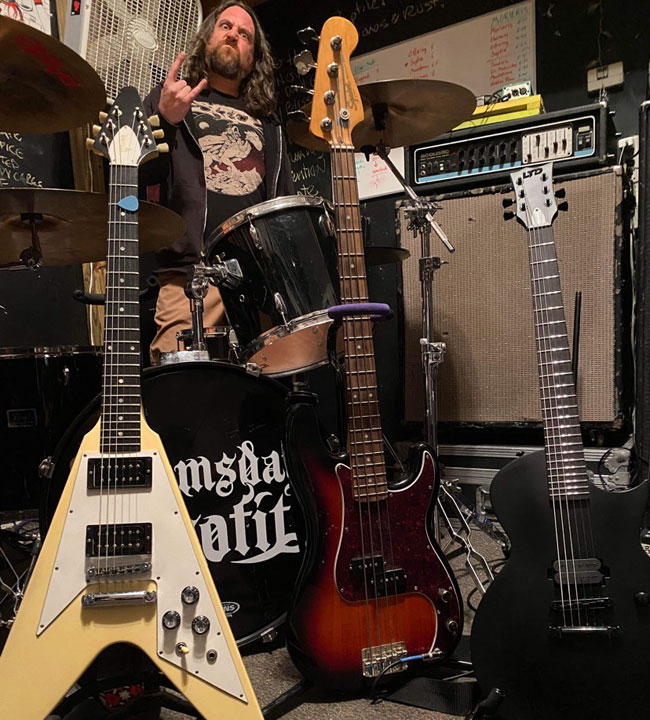
Those are all great points and I appreciate the advice. As a fan, one of my favorite songs is Cestoda. I’m curious what songs are you proud of?
Bryan: I think it goes without saying we’re all pretty proud of what we put out so far. I hope it’s a first step of a long journey that gets better. I like to think every step will be a step forward. I’m probably fooling myself to think that’s always the case. I’m pretty proud of Crown Of Flies. I think that’s my favorite on the new record but it’s also the most topical, just because of the whole pandemic nonsense over the past couple years. It’s my time capsule song.
At this stage of the band, we’re still trying to figure out who we are and what we’re capable of. I don’t think we have anything that’s the definitive Doomsday Prophet song with a definitive Doomsday Prophet riff at this point and I’m happy about that. I’m glad we haven’t peaked with our debut and that we are still inspired in coming up with ideas. This is the first band that I’ve been in that has made it to this active band status and touring outside of town with an actual album. I’m pretty proud we were able to put that out into the world.
Kevin: I’m proud of all of it and stand behind everything we did but seeing how people react to stuff on the first album is amazing. I think the end of Cestoda is what I’ve heard the most nice things about at shows and I am really proud of how we all came together with Bryan’s phaser while Tradd and Sweeney switch up the rhythm section. I listen to a lot of jam bands, not a whole lot of metal actually, and the whole band coming together and progressing through a section in a way you wouldn’t necessarily expect in this genre.
Ryan: I think I might be most proud of Bring Out Your Dead because it’s the first time I went into something relatively blind and improvised, the first and only take sounded better than I ever thought it would. As far as composed song, I’d probably also add that I’m proud of my riff on Monument To Nothing. At the time, or even still today, it was probably the most-involved riff that I’ve written. I’ve struggled with playing the same thing over and over, and I think this song broke me of that, just sitting on the same pattern, speeding it up really fast and slowing it down. I always feel a pretty good rush after playing it with the band.
I think I might be most proud of Bring Out Your Dead because it’s the first time I went into something relatively blind and improvised…
What are you guys listening to for enjoyment?
Kevin: The past couple of days and maybe this will surprise you Brian because we were just on tour with them, but I’ve just been listening to Cosmic Reaper on repeat.
[Holds up Cosmic Reaper album] I get it, I have it out right here!
Kevin: Yeah, Wasteland Part II has been stuck in my head, I’ve been going back to that this week.
Bryan: I told everybody to spend this month listening to Mental Funeral by Autopsy because I love that album [laughs]. I’ve been listening to more psych stuff like Ufommamut and a band called Psychic Lemon and of course the usual suspects of Conan, Sourvein all that heavy dirty doom and sludge. I do go back-and-forth and decide I want to, not any formal study, but focus on a particular sound or approach to see what I can pull out of it.
Lately I’ve been trying to listen to things with more space and textual elements, than just blues riffs, because a lot of the bands billed as psychedelic are just playing doom with a phaser [laughs], or bands that are billed as heavy psych are just louder and not necessarily heavy, as in doom and sludge, and not what I want to hear. I’m trying to find the inner sections that maybe haven’t been explored yet and see what I could bring to the table. We started to mine some of those ideas and find some things that look promising. We’ll see how they shape up as hopefully next time you see us we’ll have a whole batch of new songs for you.
Kevin: I’ve also been on a big weird stuff kick. I’ve been listening to Primus, Les Claypool, and a lot of Buckethead.
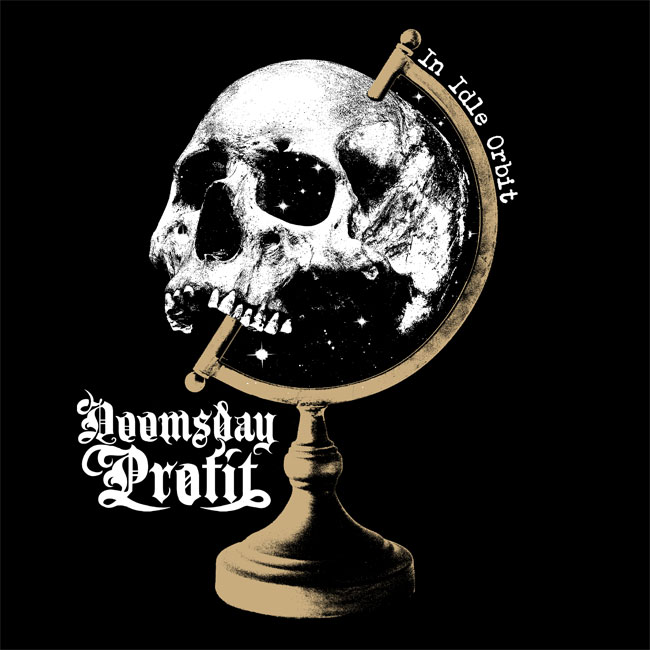
Ahh, Buckethead, you have a lot to sift through with him, that should keep you busy [laughs].
Kevin: I love everything about what Buckethead is doing.
Bryan: Its funny we don’t often get into bands with deep catalogs of music that are impenetrable and hard to find but saying that Ryan is a huge Frank Zappa fan and that’s probably his all-time favorite.
Kevin: [Laughs] I love you say that for him.
Bryan: I feel comfortable saying that for him.
Kevin: Yeah, you’re right.
I’m going to text him this question since he had to unfortunately leave early so well see what he says.
Bryan: I don’t know that he will say he’s been listening to Frank Zappa recently, but I would say that’s the one that runs through his veins at this point. He’s all over the place because he has his radio show. He’s finding stuff from all over the world for that. Global Garage on WHUP in Hillsborough, I think it airs on Sundays. They do rock ‘n’ roll broadly defined from all over the world and interviews so he’s always digging through new music.
I love everything about what Buckethead is doing…
After messaging Ryan, this was his reply to what he’s currently listening to…
Ryan: As for what I’m currently listening to, I don’t have one particular artist or album that stands out right now as most of my listening has been, and will likely be, for Global Garage. As I type this, I’m listening to our playlist for the upcoming 1/16 show which is focused on the modern Japanese underground rock scene (last week’s episode was focused on the 80s punk & post-punk scene in Japan) and I’ll be switching gears slightly as I listen to the 1/23 playlist that was curated by Dylan Gonzalez of Diary of Doom who is curating a playlist focused on Japanese doom/doom tangential music.
This is our first month switching up the formatting for Global Garage. My co-hosts and I are trying a new monthly breakdown. The first month serves as a kind of a retrospective/recent music round-up (in January it was a favorites of 2021 episode). The second show of the month looks back at place and time in history, while the third looks at a modern scene. The fourth episode will be a guest curated and/or interview episode. If there’s a fifth show of the month, that’s a free-reign episode for Paul and Chris (they’re really into noise and experimental stuff).
This month is obviously focused on Japan. Next month is, tentatively, focused on Italy if I can snag the guest I have my sights on. I’m really excited about that, so I’ll probably be listening to a lot of old-school Italian occult rock & psych in February. Between all that I’ll probably get in the mood to listen to something out of the blue like Charlie Parker, The Weeknd, Kacey Musgraves, or Jean Sibelius. I’m not listening to them at the moment but I’m very much looking forward to a lot of new releases this year: Space Coke, Messa, Izzy & The Black Trees, Abronia, Imarhan, and Konvent.
Thank you guys for taking the time to talk with me. This was an awesome evening and look forward to doing it again one day. Can’t wait for the new music and to see you guys live again soon!
Label: Independent
Band Links: Official | Facebook | Bandcamp | Twitter | Instagram
Interviewed by: Josh Schneider
